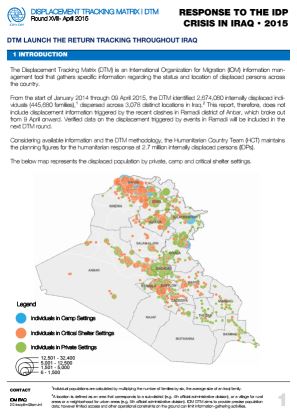-
Countries
-
Data and Analysis
-
Special Focus
-
Crisis Responses
Iraq — Displacement Report 18 (April 2015)

Contact
DTM Iraq, IraqDTM@iom.int
Language
English
Location
Iraq
Period Covered
Mar 26 2015
Apr 09 2015
Activity
- Mobility Tracking
- Baseline Assessment
This round identified a net decrease in the displaced population of 9,588 individuals’. The situation, however, remains highly fluid and variances in figures were observed throughout several governorates. In particular, significant decreases were reported in Diyala (15,852 individuals), Kirkuk (14,070 individuals), and Salah al Din (2,862 individuals). These decreases were predominantly noted in critical shelter arrangements as families have begun to return to areas primarily within those governorates. In Baghdad, a net increase of 4,104 displaced individuals, primarily in the district of Adhamia. These populations mainly originate from Anbar (2,400 individuals), followed by Baghdad and Salah al din (1,092 and 636 individuals, respectively). In the first round of returnee tracking and as of 09 April, a total of 16,519 returnee families (an estimated 99,114 individuals) were reported to have returned to their area of habitual residence across five governorates. Of this tracked population, 41% were identified in Diyala, 27% in Salah al-Din, 25% in Ninewa, 6% in Anbar, and 1% in Kirkuk. From the start of January 2014 through 09 April 2015, the DTM identified 2,674,080 internally displaced individuals (445,680 families), dispersed across 3,078 distinct locations in Iraq. This report, therefore, does not include displacement information triggered by the recent clashes in Ramadi district of Anbar, which broke out from 9 April onward. Verified data on the displacement triggered by events in Ramadi will be included in the next DTM round. Considering available information and the DTM methodology, the Humanitarian Country Team (HCT) maintains the planning figures for the humanitarian response at 2.7 million internally displaced persons (IDPs).